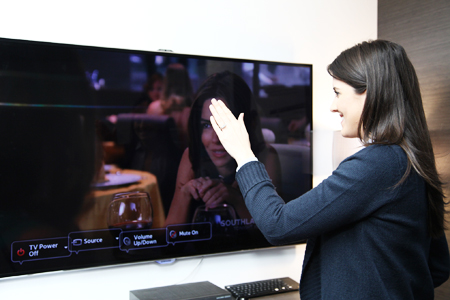
Television becoming interactive
For a long time, television has been regarded as a one-way medium, with viewers passively sitting and watching.
But with the penetration of smart devices, television is becoming an increasingly interactive medium, where people can share their ideas and opinions or recommend content through social networking services. Many people find themselves engaged in chatting and sharing opinions about programs while watching them, using smart devices.
Cheon Wang-seong, a researcher at KT research Institute, said in a report that television has the potential to become a social medium. “Talking while watching television is an activity familiar to many and they have been doing it in the past as well as now,” he said.
He went on to say that people prefer watching sports or dramas together. They also send text messages to broadcasters to make their opinion known on the bottom of the screen in real time. These are examples of television’s social aspect, according to Cheon.
“On average around 30,000 replies are posted on portals in real time for each professional baseball game. Or the numerous evaluations posted on the bulletin boards of TV programs or on blogs and Internet cafes show how much people want to express their ideas while watching television,” he said.
Smart devices make TV interactive, social
While the desire for the interactive aspects of television existed in the past, the expansion of smart devices now allows people to express and convey their ideas on what they watch.
Previously, using desktop computers or paid text messages via cell phones ― the only means of expressing ideas on television ― was burdensome and costly. Viewers couldn’t immediately express their ideas and feelings as they had to turn on their computers and lost the idea or inspiration. “Smartphones, which show information on TV programs and through which people can input text right away, are good solutions. The expansion of social networking services where people can send their ideas, or multi-screens which enable watching programs on desktops or smartphones are also helping the development of social television,” Cheon said. According to a survey on U.S. consumers by Nielson Media, seven out of 10 owners of smart devices were using them while watching television, turning sets from “lean-back” to “sit-forward” devices.
Diverse services
Television is becoming interactive in diverse ways. The most common are mobile applications that work on smartphones or tablets. A social networking service called “TV Talkers” enables people to communicate with people watching the same program. They can also network among themselves. “TV Stalker,” a social TV application, lets people talk while watching dramas. They can also share information on product placement or diverse brand goods and places indirectly advertised on the show.
Broadcasters are also launching similar apps. They welcome “social TV” as an aspect that can motivate viewers to continue their interest in the program, pulling up the viewing rate.
Smart TV manufacturers have supported such televisions by adding social networking services to the sets, so that people can post on them regarding what they watch. <Korea Times/Yoon Ja-young>


